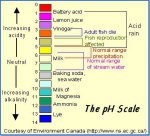Yep, agree with most of the posts above.
Stay away from those pond store pH downer or pH upper products. There are much cheaper and more pure alternatives out there. In particular, the pH downer products often use a phosphoric acid and this acid leaves a residual of phosphates that can encourage
particular species to show rampant algae growth.
More important to have a
stable and
steady pH.
Be sure to aerate the tap water before you test it. Thread,
pH level, post#13 and #14 shares examples of what you can use to aerate the tap water. Use one of these tools to fill a glass or bucket with the aerated tap water and possibly operate a small aquarium air stone/pump to further aerate it for a few hours or so, then use
this water to fill your test vial. Carbon dioxide builds up in tap water and, with a low alkalinity, then the carbon dioxide creates a carbonic acid to
artificially lower the tap water's pH. Aerating forces this carbonic acid to release carbon dioxide out of the water and this causes the pH to rise. This is quite likely why your tap water's pH is 7.6 and your pond water pH is 8.2 since the water gets aerated when entering the pond and further aerated by the pond's fountains, waterfalls, etc. Also, your water's pH likely increased to 8.2 after aeration due to all of the trace residuals from the water treatment plant.
Koi and goldfish can thrive quite well in 8.3~8.5 pH, within a variance of +/-
.2, although their appearance may likely be different at this pH level. Keep in mind the liquid test kits have an accuracy of +/-
.2 and test strips have an even worst accuracy.
The perfect pH for these fish depends on the fish's enzymes and blood pH. For koi and goldfish, the perfect pH is in the low 7s, around 7.0~7.4ish. pH is not an easy subject and it is not practical, depending on moneys or resources available, for everyone to keep their pH at this perfect level, but the fish are not significantly harmed if they are not at this perfect pH.
For example, my source water, pulled from a very deep aquifer, is liquid rock due to its extremely high alkalinity (16dkh, carbonate based, and 22dGH), that is also calcium deficient, so its pH is up to around 8.6~8.8. Here's a thread explaining how I am now stabilizing my pH at a lower level,
how to stabilise pH at 7.0. Alkalinity and pH is mutually exclusive. When pH goes down, then this also means the alkalinity, as measured by KH, is lower as well. The lower your KH then the less stable and steady the pH. If your source water is quite alkaline as mine, then even just "top off" water for evaporation will keep the alkalinity and pH quite high. So, in my situation, I had to entirely recreate my own source water and only use this new water as my "top off" water. In my situation, harvesting rain water would be extremely beneficial, but it just does not seem to want to rain here in my area.
>> I have simply just copied and pasted much from my previous replies in this chemistry forum subsection. So, since school never ends no matter how old folk are, I task you with this homework to read the threads in this chemistry subsection. :cheerful: Good luck to ya. :claphands:




